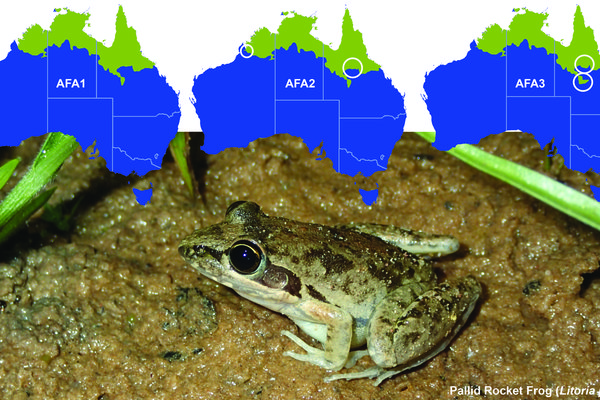The FrogID Dataset 6.0 – nearly one million frog records now published open-access and online!
The sixth annual release of FrogID data is now published open-access and online to help inform frog ecology and conservation.
Australia is home to a unique and diverse array of frog species found almost nowhere else on Earth, with 257 native species distributed throughout the continent. But Australia’s frogs are in peril – almost one in five species are threatened with extinction due to threats such as climate change, urbanisation, disease, and the spread of invasive species. With professional scientists working along citizen science programs such as FrogID, we are rapidly improving our knowledge of frog distributions and conservation. But we still have so much left to learn about Australia’s frogs and how best to halt their decline. We are even still learning just how diverse the Australian frog fauna really is – four frog species have been described as new to science in the last year alone!

© Australian Museum
Covering the first 6 years of the FrogID project, from November 2017 to November 2023, the FrogID dataset 6.0 consists of over 974,700 records of frogs – nearly one million records, spanning the entire continent.! Thanks to over 39,000 people who have contributed recordings, the published FrogID dataset has now contributed more frog occurrence records to national databases (Atlas of Living Australia) than all other sources combined.! It’s also the largest database of verified frog occurrence records for a country anywhere in the world!
The FrogID dataset 6.0 contains records of 226 of Australian frogs, including the introduced Cane Toad (Rhinella marina) – an incredible 88% of Australia’s frogs.! The Common Eastern Froglet (Crinia signifera) has remained the most commonly recorded species throughout the years, with over 183,000 records of the species published in FrogID 6.0. Some notable records in FrogID dataset 6.0 include the first FrogID records for the Chattering Rockhole Frog (Litoria staccato), the Waterfall Frog (Litoria nannotis), the Glandular Toadlet (Uperoleia glandulosa), the Northern Tapping Nursery Frog (Cophixalus exiguus), and the Kutini Boulder Frog (Cophixalus kulakula).

© Jodi Rowley
The FrogID dataset 6.0 contains thousands of vital records of threatened species, from just three records of the Critically Endangered Kroombit Tree Frog (Litoria kroombitensis) to over 2,600 records of the tiny Endangered Sloane’s Froglet (Crinia sloanei). Following ethical data publication guidelines, we consider certain, mostly threatened, frog species as ‘sensitive’ species, and the exact locality of these species is buffered to 0.1 decimal degrees (about 11km). Very highly threatened frog species recorded via FrogID, such as the Critically Endangered Wollumbin Pouched Frog (Assa wollumbin) are not included in the public dataset. This is a tiny fraction of the dataset - over 600 records - and the exact locality data for all sensitive species is provided to state biodiversity atlases to help inform conservation. They can also be requested from the FrogID project.
The taxonomy of the FrogID dataset has also been updated . We now include three of the four frog species that have been newly scientifically recognised from Australia since our last update - The Atherton Tablelands Whirring Frog (Litoria corbeni), the Ruddy Tree Frog (Litoria pyrina) and the Western Desert Tree Frog (Litoria larisonans). The remaining newly recognised species, the Eungella Whirring Tree Frog (Litoria eungellensis), known only from the Eungella Plateau in Queensland, is very poorly known and no recordings of the species have been submitted to FrogID to date. Any recordings of this species will help better understand and conserve this species which is very likely already threatened with extinction.

© Australian Museum
This expert-validated and curated dataset is a huge and growing resource, used by scientists, government, land-managers and people passionate about Australia’s frogs. Since 2017, FrogID data has contributed to over 30 scientific papers exploring frog ecology, taxonomy, and conservation (read more). In the last year alone, the FrogID database has provided insight into the diversity of calls in whistling frogs (read more), the relational nature of FrogID (read more), and contributed to the description of two new species of frog. We’ve also been calling out to FrogID users to help us understand more about the introduced Cane Toad (read more), and fill in data gaps within the Northern Wheatbelt of NSW (read more).
Grace Gillard, Technical Officer, Herpetology, Australian Museum Research Institute
Dr Jodi Rowley, Curator, Amphibian and Reptile Conservation Biology, Australian Museum Research Institute and UNSW Sydney
Primary citation for FrogID data
Rowley JJL, & Callaghan CT (2020) The FrogID dataset: expert-validated occurrence records of Australia’s frogs collected by citizen scientists. ZooKeys 912: 139-151
More information
Explore data through the FrogID website
Data published through Atlas of Living Australia
FrogID publications https://www.frogid.net.au/science
Acknowledgements
We would like to thank the Citizen Science Grants of the Australian Government and the Impact Grants program of IBM Australia for providing funding and resources to help build the initial FrogID App; the generous donors who have provided funding for the project; the Museum and Art Gallery of the Northern Territory, Queensland Museum, South Australian Museum, Tasmanian Museum and Art Gallery, and Western Australian Museum as FrogID partner museums; the many Australian Museum staff and volunteers who make up the FrogID team; and, most importantly, the thousands of citizen scientists across Australia who have volunteered their time to record frogs.












